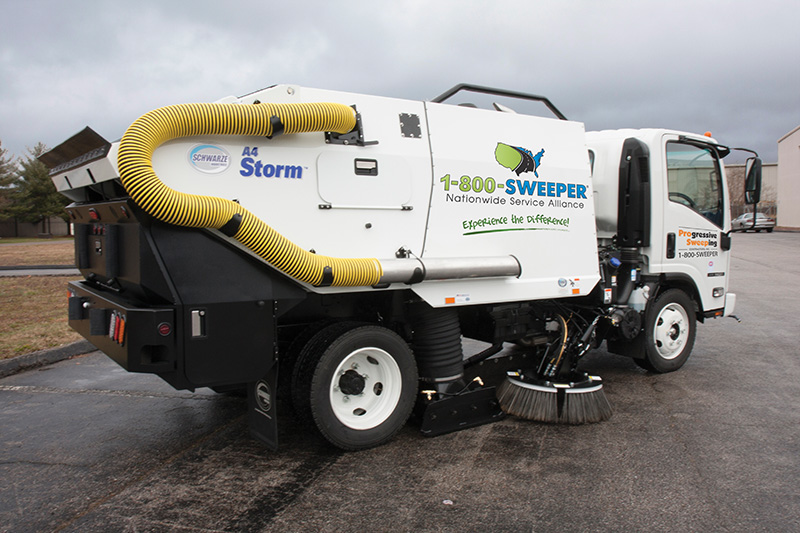Effective sweeping practices from the pros.
By Kerry Porter
Facility and property managers the world over understand and appreciate the aesthetic value that parking lot and street sweeping service brings to their properties. Clean parking lots and streets are not only pleasing to the eye, but also help protect cars and property. It also decreases floor damage caused by foot traffic and dangerous debris. However, there is another benefit to parking lot and street sweeping that most property managers overlook: environmental protection. The U.S. Environmental Protection Agency (EPA) ranks street and parking lot sweeping as the Number 1 most effective method to prevent hazardous particles and pollution from entering catch basins as stormwater runoff and ultimately into our streams, rivers and lakes.
The fine particulates that collect on streets and parking lots are a toxic cocktail of automotive fluids, break dust, dirt and fertilizers. If not properly removed, this toxic brew remains on pavement surfaces until it is either washed into our waterways as stormwater pollution, or until it is disturbed and enters our air as fugitive dust that damages property and is hazardous to our health.
 In the past four decades, many surveys from the United States Geological Survey (USGS) have been conducted on the effectiveness of power sweeping in reducing pollutants. These surveys were preformed in real world scenarios, on city streets and private properties across Unites States during different times of the year, and under a wide range of conditions. From these various studies there are some universal best practices that help to maximize the effectiveness of street and parking lot sweeping.
In the past four decades, many surveys from the United States Geological Survey (USGS) have been conducted on the effectiveness of power sweeping in reducing pollutants. These surveys were preformed in real world scenarios, on city streets and private properties across Unites States during different times of the year, and under a wide range of conditions. From these various studies there are some universal best practices that help to maximize the effectiveness of street and parking lot sweeping.
1. Sweep Often
It is recommended that parking lots be swept at least twice a year depending on the climate: (1) after the winter melt; and (2) after the trees have finished dropping their leaves. In warmer climates, it is recommended that sweeping be performed at least once every 4 to 6 months. Frequent sweeping of pavement surfaces not only reduces unsightly litter, but it also helps extend the life of your property’s pavement and reduces pollution. Pavement surfaces harbor dangerous pollutants that contaminate stormwater, contribute to additional catch basin maintenance, and enter the air we breathe in the form of fugitive dust or the water we drink. Fugitive dust is detrimental to our health, but when settled, it also acts as a fine abrasive on many surfaces including flooring.
2. Right Hand Turns Are The Most Effective
When planning a route for street sweeping, it is most efficient and safest to have the sweepers make as many right turns as possible, and avoid left hand turns. Left hand turns on streets mean sweeper trucks cross traffic, creating a higher safety risk for the operator and the motoring public. Sweeping paths that optimize the use of right hand turns are more efficient and productive, help reduce traffic disruption and accident risk ensuring greater safety and cost effectiveness.
3. Use The Right Sweeper For The Right Job
One of the more difficult problems managers face is deciding which kind of sweeper truck will be the most effective for the job. The ‘Pennichuck Brook Watershed Commercial/Industrial Sweeping/Catch Basin Cleaning Feasibility’ report1 prepared in 2012 by Comprehensive Environmental, Inc. for New Hampshire-based Pennichuck Water Works sheds light on this complex matter. The report’s findings are the same as many USGS findings. Mechanical sweeper trucks are ideal for removing large debris, such as litter down to medium-sized particulates in all weather conditions. Regenerative air sweeper trucks are most effective in dry conditions for removing medium to small particulates that mostly make up the more dangerous and damaging of urban pollution: fugitive dust and stormwater runoff contaminates that harm our fresh water supply and the air we breathe.
4. Manage Your Costs
A number of sweeping studies also consider the cost effectiveness of a property owner owning and running his or her own sweeper truck versus outsourcing the work to a sweeping vendor. Specifically, the Pennichuck Brook Watershed report provides great insight into the matter of which is more cost-effective: a sweeping service vendor or purchasing and running sweeper trucks in-house. In most situations, it is more cost-effective and effective to hire an outside sweeping vendor for annual property sweeping than it is to purchase and run the equipment.
5. Observe Conditions & Seasons
Sweeping pavement is most efficient when there are fewer obstacles present. Parked cars and dumpsters reduce the effectiveness of sweeping by preventing large areas of pavement from being cleaned and hampering sweeper movement. Most parking lot sweeper trucks are run during the evening hours to reduce the amount of impediment to their work. Sweeper trucks are proven to be most effective in dry weather conditions. This means that for maximum protective value to both paved surfaces and the environment, weather conditions should be factored in.
Regardless of whether a property manager owns his or her own sweeper trucks, or hires a sweeping contractor to perform the work for the property, the most important thing is that properties receive regular or annual sweeping. By implementing and observing effective sweeping practices, property managers can not only improve the aesthetic value of their retail properties, but they also act as a partner in the war against pollution.
1 http://www.pennichuck.com/StreetSweepingCatchBasinProgramFinalReport.pdf
— Kerry Porter is marketing manager of ProSweep, which offers professional power sweeping services for Northwest Ohio and Southeastern Michigan. ProSweep has been in business since 1978, and is family owned. ProSweep is also a founding member of 1-800-SWEEPER. Email the author at [email protected].
